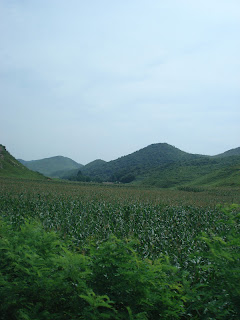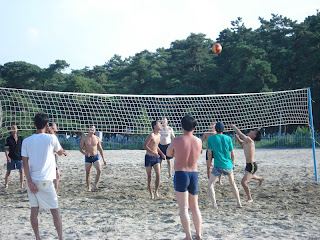 |
| A view of the countryside. |
I was fortunate enough to have time to visit, not only Pyongyang, Kaesong and the DMZ, but The eastern port city of Wonsan as well. Wonsan (
원산), is the capital of North Korean portion of the beautifully mountainous Kangwon province (강원도). It has seen several centuries of history as a port city, though you wouldn't know this to look at it as it remained under siege for the entire duration of the Korean War (March 1951 to 1953) with nearly nothing remaining of it by the end. Wonsan is a popular destination for North Korean holiday-makers (Yes, they do go on holiday! Many take the train from major cities or simply wait along the roadside by their farms for suitable transportation to come along. Kim Jong-il also had a nearby villa.). Wonsan is famous in the DPRK for a number of reasons, not the least of which is it's presence next to the lovely Songdowon Beach (송도원) and it's proximity to supposedly stunning Ulim waterfalls (sadly, the road had been washed out by recent rains, so we didn't get the chance to go). Other nearby sites which are much more interesting for the few foreign tourists who visit than they are for DPRK citizens are the Songdowon International Children's camp, where youths from Russia and a variety of African countries still come to spend a few weeks in the summer getting to know their North Korean compatriots, and Chonsam (천삼) Co-operative farm, one of the only working farms which foreigners are currently able to visit.
My visit to Wonsan, combined with taking the train out through the northwestern town of Shinuiju provided me with ample opportunity to enjoy views of the countryside in the southern and western portions of the country. This opportunity was made even better when we encountered a blocked tunnel en route to Wonsan and had to wait nearly an hour alongside the locals while it was cleared by the army.








































No comments:
Post a Comment